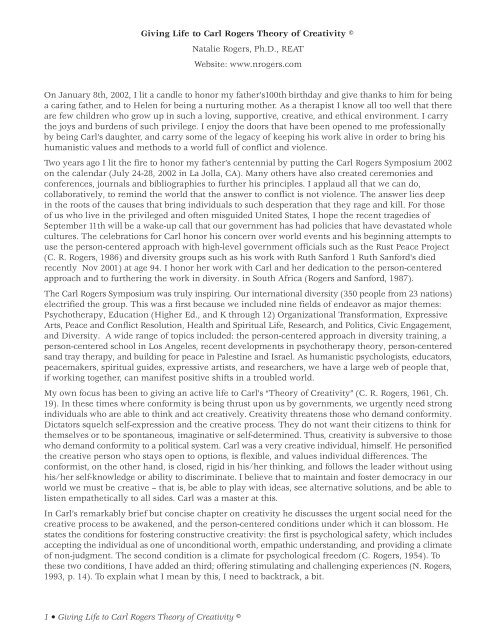Giving Life to Carl Rogers Theory of Creativity © Natalie Rogers, Ph ...
Giving Life to Carl Rogers Theory of Creativity © Natalie Rogers, Ph ...
Giving Life to Carl Rogers Theory of Creativity © Natalie Rogers, Ph ...
Create successful ePaper yourself
Turn your PDF publications into a flip-book with our unique Google optimized e-Paper software.
<strong>Giving</strong> <strong>Life</strong> <strong>to</strong> <strong>Carl</strong> <strong>Rogers</strong> <strong>Theory</strong> <strong>of</strong> <strong>Creativity</strong> ©<br />
<strong>Natalie</strong> <strong>Rogers</strong>, <strong>Ph</strong>.D., REAT<br />
Website: www.nrogers.com<br />
On January 8th, 2002, I lit a candle <strong>to</strong> honor my father’s100th birthday and give thanks <strong>to</strong> him for being<br />
a caring father, and <strong>to</strong> Helen for being a nurturing mother. As a therapist I know all <strong>to</strong>o well that there<br />
are few children who grow up in such a loving, supportive, creative, and ethical environment. I carry<br />
the joys and burdens <strong>of</strong> such privilege. I enjoy the doors that have been opened <strong>to</strong> me pr<strong>of</strong>essionally<br />
by being <strong>Carl</strong>’s daughter, and carry some <strong>of</strong> the legacy <strong>of</strong> keeping his work alive in order <strong>to</strong> bring his<br />
humanistic values and methods <strong>to</strong> a world full <strong>of</strong> conflict and violence.<br />
Two years ago I lit the fire <strong>to</strong> honor my father’s centennial by putting the <strong>Carl</strong> <strong>Rogers</strong> Symposium 2002<br />
on the calendar (July 24-28, 2002 in La Jolla, CA). Many others have also created ceremonies and<br />
conferences, journals and bibliographies <strong>to</strong> further his principles. I applaud all that we can do,<br />
collaboratively, <strong>to</strong> remind the world that the answer <strong>to</strong> conflict is not violence. The answer lies deep<br />
in the roots <strong>of</strong> the causes that bring individuals <strong>to</strong> such desperation that they rage and kill. For those<br />
<strong>of</strong> us who live in the privileged and <strong>of</strong>ten misguided United States, I hope the recent tragedies <strong>of</strong><br />
September 11th will be a wake-up call that our government has had policies that have devastated whole<br />
cultures. The celebrations for <strong>Carl</strong> honor his concern over world events and his beginning attempts <strong>to</strong><br />
use the person-centered approach with high-level government <strong>of</strong>ficials such as the Rust Peace Project<br />
(C. R. <strong>Rogers</strong>, 1986) and diversity groups such as his work with Ruth Sanford 1 Ruth Sanford's died<br />
recently Nov 2001) at age 94. I honor her work with <strong>Carl</strong> and her dedication <strong>to</strong> the person-centered<br />
approach and <strong>to</strong> furthering the work in diversity. in South Africa (<strong>Rogers</strong> and Sanford, 1987).<br />
The <strong>Carl</strong> <strong>Rogers</strong> Symposium was truly inspiring. Our international diversity (350 people from 23 nations)<br />
electrified the group. This was a first because we included nine fields <strong>of</strong> endeavor as major themes:<br />
Psychotherapy, Education (Higher Ed., and K through 12) Organizational Transformation, Expressive<br />
Arts, Peace and Conflict Resolution, Health and Spiritual <strong>Life</strong>, Research, and Politics, Civic Engagement,<br />
and Diversity. A wide range <strong>of</strong> <strong>to</strong>pics included: the person-centered approach in diversity training, a<br />
person-centered school in Los Angeles, recent developments in psychotherapy theory, person-centered<br />
sand tray therapy, and building for peace in Palestine and Israel. As humanistic psychologists, educa<strong>to</strong>rs,<br />
peacemakers, spiritual guides, expressive artists, and researchers, we have a large web <strong>of</strong> people that,<br />
if working <strong>to</strong>gether, can manifest positive shifts in a troubled world.<br />
My own focus has been <strong>to</strong> giving an active life <strong>to</strong> <strong>Carl</strong>’s “<strong>Theory</strong> <strong>of</strong> <strong>Creativity</strong>” (C. R. <strong>Rogers</strong>, 1961, Ch.<br />
19). In these times where conformity is being thrust upon us by governments, we urgently need strong<br />
individuals who are able <strong>to</strong> think and act creatively. <strong>Creativity</strong> threatens those who demand conformity.<br />
Dicta<strong>to</strong>rs squelch self-expression and the creative process. They do not want their citizens <strong>to</strong> think for<br />
themselves or <strong>to</strong> be spontaneous, imaginative or self-determined. Thus, creativity is subversive <strong>to</strong> those<br />
who demand conformity <strong>to</strong> a political system. <strong>Carl</strong> was a very creative individual, himself. He personified<br />
the creative person who stays open <strong>to</strong> options, is flexible, and values individual differences. The<br />
conformist, on the other hand, is closed, rigid in his/her thinking, and follows the leader without using<br />
his/her self-knowledge or ability <strong>to</strong> discriminate. I believe that <strong>to</strong> maintain and foster democracy in our<br />
world we must be creative – that is, be able <strong>to</strong> play with ideas, see alternative solutions, and be able <strong>to</strong><br />
listen empathetically <strong>to</strong> all sides. <strong>Carl</strong> was a master at this.<br />
In <strong>Carl</strong>’s remarkably brief but concise chapter on creativity he discusses the urgent social need for the<br />
creative process <strong>to</strong> be awakened, and the person-centered conditions under which it can blossom. He<br />
states the conditions for fostering constructive creativity: the first is psychological safety, which includes<br />
accepting the individual as one <strong>of</strong> unconditional worth, empathic understanding, and providing a climate<br />
<strong>of</strong> non-judgment. The second condition is a climate for psychological freedom (C. <strong>Rogers</strong>, 1954). To<br />
these two conditions, I have added an third; <strong>of</strong>fering stimulating and challenging experiences (N. <strong>Rogers</strong>,<br />
1993, p. 14). To explain what I mean by this, I need <strong>to</strong> backtrack, a bit.<br />
1 • <strong>Giving</strong> <strong>Life</strong> <strong>to</strong> <strong>Carl</strong> <strong>Rogers</strong> <strong>Theory</strong> <strong>of</strong> <strong>Creativity</strong> ©
My expressive arts work evolved when I moved from Bos<strong>to</strong>n <strong>to</strong> California and asked my Dad if I could<br />
work with him. He was delighted, <strong>of</strong> course. I quickly designed a ten-day intensive workshop. We<br />
asked six <strong>to</strong> eight other staff <strong>to</strong> join us and we then co-created what was called the Person-Centered<br />
Approach workshops. The staff included at various times; <strong>Carl</strong> <strong>Rogers</strong>, and Maria Bowen, Frances<br />
Fuchs, Maureen O’Hara, Joann Justyn, Jared Kass, Betty Meador, Alan Nelson, <strong>Natalie</strong> <strong>Rogers</strong> John<br />
K. Wood, Dick and Marion Vitti<strong>to</strong>w. Because <strong>of</strong> Dad’s appeal around the world, it was easy <strong>to</strong> get a<br />
huge crowd for ten days. These were international workshops during very experimental times. As<br />
staff we learned as much, or more, than the participants. Day after day the large group would sit<br />
talking about their lives, telling their personal s<strong>to</strong>ries full <strong>of</strong> emotional content – their tragedies,<br />
confusion, fear, and dilemmas. As staff, we were very good at reflecting their feelings and holding<br />
the safe space for these very personal moments. We also knew how <strong>to</strong> facilitate the confrontations<br />
people had with each other.<br />
However, because I am such a kinesthetic person, I became very restless and thought, “How can we<br />
sit here for three hours in the morning, three hours in the afternoon and three hours in the evening”<br />
So, I finally said, “I have a studio room with art materials, and anybody who would like <strong>to</strong> find other<br />
ways <strong>of</strong> delving in<strong>to</strong> these personal issues can come and join me. We will experiment with non-verbal<br />
ways <strong>to</strong> talk about all the s<strong>to</strong>ries we are sharing, and we will use movement, art, sound and drama<br />
for self-exploration.” I had several colleagues who were also interested in exploring this with me Jared<br />
Kass and Maria Bowen. We created playtimes that were deeply meaningful <strong>to</strong> people. We had very<br />
few guidelines. We just kept learning from what we were doing. The way <strong>to</strong> become a good facilita<strong>to</strong>r<br />
is <strong>to</strong> constantly get evaluations and feedback from participants and ask, “What are we learning What<br />
works and doesn’t work” We found that our ability <strong>to</strong> play, <strong>to</strong> use costumes, drama, and role playing<br />
as well as using art materials was very meaningful <strong>to</strong> people.<br />
What I now call “the Creative Connection”(N. <strong>Rogers</strong>, 1993, p. 27-130) evolved. We discovered that<br />
using movement, visual art, sound and journal writing in sequence with very little verbalization<br />
helped us tap in<strong>to</strong> our unconscious and our archetypal persona, bringing insight <strong>to</strong> our personal issues.<br />
As facilita<strong>to</strong>rs we suggested possibilities for these experiments, but in true person-centered fashion<br />
(C. R.<strong>Rogers</strong>, 1970, p. 43-59), we always checked this out with the individual involved. The client or<br />
the group member may choose <strong>to</strong> participate, or not, and we follow her lead. We created a safe, nonjudgmental<br />
environment, giving people both stimulus and permission <strong>to</strong> take <strong>of</strong>f their social masks<br />
<strong>to</strong> discover inner truths. After an hour or more <strong>of</strong> this engaging creative process, we talk about what<br />
we had learned through our art. This was the time for deep, empathic listening. We never interpret<br />
a person’s art. I am as adamantly opposed <strong>to</strong> analytic art therapy as <strong>Carl</strong> was <strong>to</strong> analytic psychotherapy<br />
(Bar<strong>to</strong>n, 1974).<br />
Experiments or experiences designed <strong>to</strong> involve the individual in the expressive arts give that person<br />
the opportunity <strong>to</strong> engage in the magic <strong>of</strong> the creative process and learn by doing (N. <strong>Rogers</strong>, 1993).<br />
This is where I feel my work has been an expansion <strong>of</strong> <strong>Carl</strong>’s work. For a while I felt I was being a<br />
bit rebellious <strong>to</strong> take his work and actually create exercises that would stimulate people <strong>to</strong> use art and<br />
movement, sound and journal writing for self-expression. I had worked with my father for many<br />
years, and taken classes from him, and knew his philosophy and methods very well. I had incorporated<br />
them in<strong>to</strong> my own way <strong>of</strong> being. So, <strong>to</strong> do something a little different was a difficult process for me<br />
at the beginning. Then I realized I was actually breathing life in<strong>to</strong> his theory <strong>of</strong> creativity.<br />
One further point: using the expressive arts gives people a safe place <strong>to</strong> explore their shadow side.<br />
In my book, The Creative Connection (1993), I spend one chapter talking about accepting the shadow,<br />
embracing the light. The shadow is the part we have repressed in our lives (Zweig 1991). Some people<br />
have denied their anger and rage for a lifetime. Others have hidden or denied their ability <strong>to</strong> love or<br />
be compassionate. Using movement, sound, color and drama <strong>of</strong>fer opportunities <strong>to</strong> first become aware<br />
<strong>of</strong> one’s shadow, and then <strong>to</strong> explore it fully through many media. Fear and grief are <strong>of</strong>ten more easily<br />
expressed in paintings or movement than in words. Rage can be splashed on large sheets <strong>of</strong> paper<br />
until some <strong>of</strong> the energy has been released and transformed. Such authentic self-expression if<br />
experienced in a compassionate,therapeutic environment helps the individual <strong>to</strong> release energy, gain<br />
insight, and take responsibility for his/her feelings and move <strong>to</strong>ward constructive action. Ultimately<br />
this leads <strong>to</strong> improved self-esteem and an ability <strong>to</strong> give and receive love.<br />
2 • <strong>Giving</strong> <strong>Life</strong> <strong>to</strong> <strong>Carl</strong> <strong>Rogers</strong> <strong>Theory</strong> <strong>of</strong> <strong>Creativity</strong> ©
Most <strong>of</strong> us who knew <strong>Carl</strong> realize that he had difficulty acknowledging or expressing his anger in person.<br />
(He could do it in letter writing, occasionally). It should not surprise anyone, therefore, that I was eager<br />
<strong>to</strong> create a person-centered environment where people could delve in<strong>to</strong> these feelings <strong>of</strong> rage or fear,<br />
or shame, in non-verbal as well as verbal forms.<br />
With humankind in such a volatile state <strong>of</strong> rage, violence, loss, grief, and confusion, coupled with<br />
outpourings <strong>of</strong> generosity, compassion and love, I feel the place for person-centered expressive arts<br />
therapy is timely. It is timely for those <strong>of</strong> us who are capable <strong>of</strong> facilitating the healing <strong>of</strong> the grief, anger<br />
and pain and the sense <strong>of</strong> hopelessness. It is time for us <strong>to</strong> move in<strong>to</strong> communities <strong>to</strong> help people find<br />
their sense <strong>of</strong> empowerment through the arts. The creative process is a life force energy. If <strong>of</strong>fered in<br />
a safe, empathic, non-judgmental environment, it is a transformative process for constructive change.<br />
It is <strong>Carl</strong> <strong>Rogers</strong> who has <strong>of</strong>fered us the theory and methods in the person-centered approach that gives<br />
us the firm foundation on which <strong>to</strong> build. One <strong>of</strong> his greatest qualities was his ability <strong>to</strong> stay open <strong>to</strong> new<br />
ideas and learn from his own experience. In celebrating his life, I hope we will be inspired by his way<br />
<strong>of</strong> being.<br />
References<br />
Bar<strong>to</strong>n, A. (1974). Three worlds <strong>of</strong> therapy: An existential-phenomenological study <strong>of</strong> the therapies <strong>of</strong><br />
Freud, Jung, and <strong>Rogers</strong>. Palo Al<strong>to</strong>, California: National Press Books.<br />
<strong>Rogers</strong>, <strong>Carl</strong> R. (1954). Towards a theory <strong>of</strong> creativity. ETC: A Review <strong>of</strong> General Semantics 11, 249-260.<br />
<strong>Rogers</strong>, <strong>Carl</strong> R. (1961). On becoming a person: A therapist’s view <strong>of</strong> psychotherapy. Bos<strong>to</strong>n: Hough<strong>to</strong>n<br />
Mifflin. Republished 1965 and 1995.<br />
<strong>Rogers</strong>, <strong>Carl</strong> R. (1970). <strong>Carl</strong> <strong>Rogers</strong> on encounter groups. New York: Harper and Row.<br />
<strong>Rogers</strong>, <strong>Carl</strong> R. (1986, Summer). The Rust Workshop: A personal overview. Journal <strong>of</strong> Humanistic<br />
Psychology, 26, (3), 23-45.<br />
<strong>Rogers</strong>, <strong>Carl</strong> R. and Ruth Sanford. (1987). Reflections on our South African experience. Counseling and<br />
Values, 32 (1), 17-20.<br />
<strong>Rogers</strong>, N. (1993). The Creative Connection: Expressive arts as healing. Palo Al<strong>to</strong>, CA: Science and<br />
Behavior Books.<br />
Zweig, C., and Abram, J. (Eds.). (1991). Meeting the shadow: the hidden power <strong>of</strong> the dark side <strong>of</strong> human<br />
nature. Los Angeles, CA: Jeremy P. Tarcher, Inc.<br />
Resources<br />
A new book, <strong>Carl</strong> <strong>Rogers</strong> the Quiet Revolutionary an Oral His<strong>to</strong>ry, was released the week <strong>of</strong> the Symposium.<br />
This is <strong>Carl</strong> <strong>Rogers</strong>, in his own words, as interviewed by archivist David Russell. To order go <strong>to</strong>:<br />
A CD-ROM, <strong>Carl</strong> <strong>Rogers</strong>: A Daughter’s Tribute, was also released. The CD includes excerpts from each <strong>of</strong><br />
<strong>Carl</strong> <strong>Rogers</strong>’ books, his private letters and journals, and pho<strong>to</strong>s and videos from his life. To order go <strong>to</strong><br />
the Website: http://www.mindgardenmedia.com/cr.html<br />
The Symposium was recorded by Conference Recording Service. To order audio tapes (FAX: 510 527-<br />
8404) or go <strong>to</strong> the Symposium Website for papers, pho<strong>to</strong>s, and on-line continued discussion:<br />
<strong>Natalie</strong> <strong>Rogers</strong>, <strong>Ph</strong>.D., is an author, artist, psychotherapist, and founder <strong>of</strong> the Person-Centered Expressive<br />
Therapy Institute. Her book, The Creative Connection: Expressive Art as Healing, joins person-centered<br />
theory and the expressive arts <strong>to</strong> facilitate deep inner work. She is the daughter <strong>of</strong> <strong>Carl</strong> <strong>Rogers</strong>.<br />
3 • <strong>Giving</strong> <strong>Life</strong> <strong>to</strong> <strong>Carl</strong> <strong>Rogers</strong> <strong>Theory</strong> <strong>of</strong> <strong>Creativity</strong> ©




